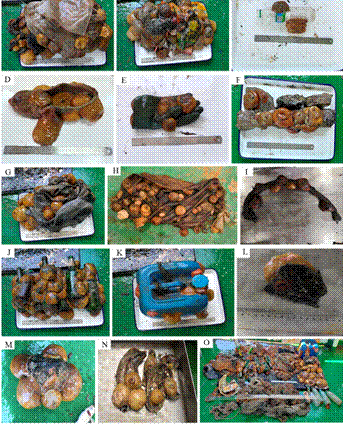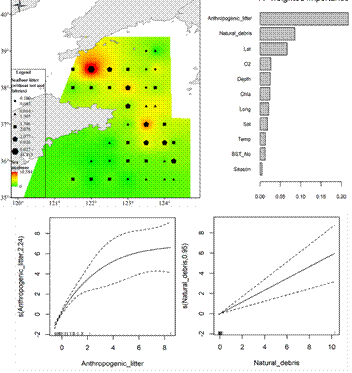Recently, Marine Fisheries Resources Ecology Unit of Yellow Sea Fisheries Research Institute published an article online entitled “Is seafloor litter contributing to sea anemone blooms?” in Science of the Total Environment (impact factor 6.551). The study was based on the bottom trawl survey for fishery resources in the Yellow Sea combined with field observation and statistical models. It is the first study on the impacts of seafloor litter on the distribution of Metridium senile fimbriatum (M. senile) and the potential impacts of sea anemone blooms on the benthic marine ecosystem. The results showed that the density of seafloor litter was an important factor positively correlated with the distribution of M. senile. On top of that, it is the first time that the interaction between seafloor litter and benthic organisms has been proven via statistical methods, which provides a new perspective to study the succession of marine ecosystem under multi-stressors.
In recent years, increasing marine litter has become a global environmental disaster. Marine litter has adverse impacts on marine environment as well as marine organisms as it will block the intestinal tracts of marine organisms, wind them and make them unable to feed and escape; through ocean currents, it will also be the carrier transporting attached organisms to other sea areas, even leading to biological invasion. Most of the floating debris are eventually deposited on the seafloor, making seafloor a huge repository of marine litter. Limited by observation methods, research methods and costs, it is difficult to conduct large-scale surveys of seafloor litter and even more difficult to observe the interaction process between seafloor litter and benthic organisms. Therefore, the mechanism of seafloor litter on benthic ecosystems was an unresolved issue.
The bottom trawl survey for fisheries provides an effective observation method for studying the distribution of seafloor litter and its ecological effects. With the help of the bottom trawl survey for fisheries, the research team obtained the seafloor litter and its data and conducted site observation of the organisms attached on the marine litter. It was found that M. senile could attach to different types of seafloor litter and the hot spots of seafloor litter overlapped with the high-density areas of M. senile. In order to further evaluate the impacts of seafloor litter and environmental factors on M. senile distribution, the research team established two models: Gradient Forest Model (GFM) and Generalized Additive Mixed Model (GAMM). Based on the model analysis, there were strong positive correlations between the density of seafloor litter and the distribution of M. senile. Therefore, the wide distribution of seafloor litter in the North Yellow Sea provides a “natural habitat” for the growth and reproduction of M. senile and a “moving carrier” for the regional diffusion of M. senile, thus creating favorable conditions for the outbreak of M. senile. In view of the environmental tolerance, complex life history and ecological characteristics of M. senile, M. senile blooms could have an impact on the structure and function of the benthic ecosystem in the North Yellow Sea. This study improved the scientific understanding of the interaction mechanism between marine litter and benthic organisms and related ecological risks and provided important scientific support for the comprehensive prevention and control of marine litter in China and global marine litter pollution control.
Ph.D. candidate Guangliang Teng from Marine fisheries Resources Ecology Unit is the first author of this paper and Dr. Xiujuan Shan from the Unit is the corresponding author. The study was funded by the National Natural Science Foundation of China (31872692), Aoshan Talents Cultivation Program Supported by Pilot National Laboratory for Marine Science and Technology (Qingdao) (2017ASTCP-ES07), Special Funds for Taishan Scholar Project of Shandong Province and the David and Lucile Packard Foundation.
The full text of the article is available on: https://doi.org/10.1016/j.scitotenv.2020.143479.

Figure 1. Metridium senile fimbriatum are attached to different types of seafloor litter

Figure 2. The main results of GFM and GAMM
